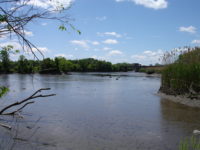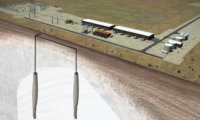Officials from the American Society of Civil Engineers and the National Oceanic and Atmospheric Administration signed a memorandum of understanding on Feb. 1 outlining plans to help ensure U.S. infrastructure is designed to be more resilient and “climate-ready.” The agreement details how NOAA science and data will inform ASCE building and civil engineering codes, standards and best practices going forward.
Leaders from ASCE, NOAA and the University of Maryland met at the engineering group's Reston, Va., headquarters on Feb. 2 to discuss the MOU and how engineers can account for climate change in design and construction of future building and infrastructure projects.
“Addressing current and long-term challenges facing communities across the nation and globe from extreme weather events requires close collaboration among the science and engineering communities,” said Tom Smith, ASCE executive director.
NOAA Administrator Rick Spinrad said the collaboration will also help staff at his agency gain a better understanding of what the engineering community needs to prepare for climate change impacts. Sustained partnerships like the ASCE-NOAA agreement “will help foster a climate-ready nation where individuals, businesses and industries have the knowledge and tools to take action to mitigate risk and support economic growth,” he said.
Partnership technical meetings and workshops will be facilitated by the university’s Center for Technology and Systems Management.
The agreement developed from a series of workshops and technical meetings ASCE and NOAA held last year that focused on how several key climate-related risks—such as extreme temperatures, rainfall events, changing wind patterns and coastal hazards—can affect the built environment.
Those technical meetings and exchanges of information will continue, said Maria Lehman, ASCE 2023 president. She noted that with enactment of the Infrastructure Investment and Jobs Act, the goalpost for engineers has moved.
“It’s important to re-think everything we are doing at ASCE,” she said, to develop standards, codes and best practices for buildings and infrastructure that are resilient not only for the next 50 years, but which also can be adapted as needs change. That will require design specifications to be less prescriptive and more performance-based.
Chris Gold, a senior principal with CLARKNEXSEN, highlighted challenges faced by engineers who wish to design buildings and facilities that are more resilient than required by building codes—but more costly than local budgets allow. He said many local codes are primarily focused on individual facilities, rather than networks of buildings. “When we look at the new generation of codes and standards, we really need to integrate community-level climate resilience,” said Gold.
An ASCE committee has begun work on the 2028 update to the group's structural design load standard, known as ASCE 7, which considers impacts of loads from earthquakes, wind, floods, tsunamis, snow and ice on the structural integrity of buildings and other structures. The committee will use data from NOAA to inform the update but will need the information by the first quarter of 2025 to be on track to adopt it into local building codes by the early 2030s.






Post a comment to this article
Report Abusive Comment